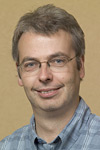|
|
|
Obtaining high luminosity beams will be crucial for the future International Linear Collider. An important indication on the beam quality is given by the emittance which depends on its size and opening angle. The lower the emittance, the easier it is to focus the beam and the more particle collisions can occur and be analysed. In the GDE the "Accelerator physics" group, a special team dedicated to the technical systems organised at CERN, on 08-11 February 2006, a "Low Emittance Transport Workshop". About 30 accelerator scientists, coming from all regions, attended it. The main purpose of the "low emittance transport" group is to make a survey of the beam from damping ring to the interaction point. "Our first objective is to deliver a lattice design which consists of defining the systems of magnets and accelerating components.", said Daniel Schulte, co-convenor of the GDE "Accelerator Physics Group", who organised the workshop with Kiyoshi Kubo and Peter Tenenbaum. Schulte is also the coordinator of the "Integrated Luminosity Performance Studies" Work Package within the EUROTeV (European Design Study Towards a Global TeV Linear Collider) European programme. Another important task for the group is to review the studies on the tuning of the systems. They will predict the performances of the machine and specify the hardware to correct the beam trajectory and improve its quality. Conventional alignment procedures are not enough in a precision machine like the ILC. At collision, the bunches of particles will be a hundred times smaller than in the previous colliders. The reason why the beam emittance is likely to grow during its path is simply because the system it crosses is not perfect. Acting like an optical lens on a beam of light, the magnets curve the beam and make it focus on a given plane. The first challenge is in a single bunch, all particles do not have the same energy. Therefore, one needs to design an achromatic system, where the beam focusing point is independent of the energy. Another challenge is the alignment of the different subsystems. An error of only a few micrometers could have dramatic impact if not compensated. To preserve the emittance obtained at the damping rings exit, the group has to specify elements for corrections, like supplementary magnets. During the machine commissioning, accelerator physicists will control the beam emittance measuring its properties along the path, with the help of beam position monitors. Dynamic effects are also expected at the ILC. For instance, the beam could be affected by the ground movement. The specificity of this group is to have a global view of the machine, following the beam path through the different subsystems. Therefore their studies require a strong collaborative effort. During the meeting, a session was dedicated to instrumentation. "To define the performance requirements of the instrumentation, we need to agree on a common model" said Schulte. To estimate the error bar to introduce in their simulation, they work closely with specialised groups. They collaborate for instance with machine detector interface scientists or specialists on an automatic survey system, just to name a few, who can provide them with many background numbers. Depending on what the group recommends for the subsystems, their studies could have an impact on the global cost of the machine - for instance on the specification of the magnets or the number of laser wires that would be needed to keep emittance low. "We will have to evaluate if our requests are within reach.", concluded Schulte. The group will provide inputs for the Reference Design Report about the expected performance of the machine along the different subsystems, which will be gathered by the GDE Design Cost Board by the end of 2006. Links: "Explain Luminosity in 60 seconds": ILC LET workshop slides: GDE: ILC Reference Design Report Wiki http://www.eurotev.org/e558/e941/index_eng.html -- Perrine Royole-Degieux |

